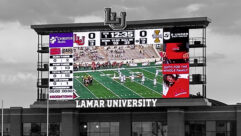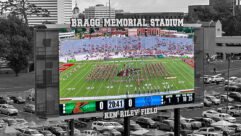
How Many Signs are Too Many?
Jul 22, 2008 12:00 PM,
By John W. DeWitt

Wal-Mart de Mexico;’s digital signage uses the FireCast player and
Linux-based OS and remote management software from Wirespring. This content
appeared on the “power aisle” channel, which uses ceiling-mounted screens in
a ring around the primary shopping area. Most Wal-Mart de Mexico stores also
have a checkout channel and a pharmacy channel, and some also feature
interactive kiosks running Wirespring’s software as well.
There are more and larger digital screens than ever—in the home, at retail, and in other public and private contexts. So is there such a thing as too many signs? Digital Signage Update talked to Bill Gerba, a digital-signage blogger and the CEO of Wirespring, to get his advice about how to achieve adequate coverage—to reach the most people most effectively—without overloading viewers (and employees who watch and/or listen all day long). Interestingly, Gerba says the number of signs is much less important than their visual and audio content.
Digital Signage Update: Is this issue of media saturation and viewer overload a greater concern for your customers than it was, say, five years ago?
Gerba: Is saturation and overload more or less prevalent? I don’t think there’s been a huge change in the media landscape over the past few years; I think we’re on a plateau right now. The sign is essentially just another piece of merchandising or point-of-purchase display. In form, it’s different, but in function, it’s exactly the same—it delivers a commercial message—so it’s subject to the filtering, avoiding, and ignoring that people use to tune out media. People still go out of their way to not look at signage.
The main benefit of digital screen is you can make it eye-catching—people have even made it annoying to make it eye-catching—but it’s clear that there is the same kind of media avoidance that you have to overcome. Steps people have taken to address it range from the good—making the content on the screen really kick-ass—to the bad—making it annoying, with ridiculous sound effects, rapid flickering, much to the chagrin of people who have to work there all day.
What is the impact of larger signs and HD content? What dictates whether the audience pays attention or tunes them out?
I would not say the larger screens and HD have had an impact that much—even the largest screens are smaller than a 24″x36″ poster in surface area, so more square inches of space are being devoted to print and static media. If it’s just visual, if there’s no audio component, research indicates that people tune it out in a manner similar to other static media—basically along the same ratio. People do tend to look more because it is animated, but the ratio of those paying attention vs. those avoiding is similar.
When you add sound, it becomes difficult to ignore and more distracting. It can be a problem when people deploying signage are not using sound appropriately, when you use something that’s annoying and hard to ignore.
When scoping a digital-signage deployment, what are the rules of thumb for achieving the right balance of coverage without overwhelming your audience?
It depends a lot on location. In general, if you have to adjust the level of sound to fight background noise, you probably should not be using sound at all. A lot of mistakes you see are on the sound side of things. A lot of the rules of thumb we talk about have to do with getting content to be recognized and remembered. Keep the content simple, so if people just glance, they get the message. Don’t rely upon complicated plot devices and story lines because people are there to shop, wander the mall, etc., and they may not be in front of the screen for the first 25 seconds of a 30-second spot. They should not have to spend much time to get something of benefit from the spot. Generally, we say don’t put more than one or two things on the screen at once. If you’re using animated text, don’t assume people will read it.
Obviously, large motions are really good at catching the attention of people not looking at the screen—but when you use the same motion on people looking at the screen, it detracts from the person’s ability to get the message. So there’s a tradeoff between using motion to capture attention and leaving space on the screen to deliver the real message.
In terms of placement, Paco Underhill’s research [he invented the concept of a “decompression zone” as you enter a retail store] indicates that a screen at the entrance not useful at all. And the closer you can put a screen to eye level, the more likely people will look at it—failure to do that is a problem in a lot of big box stores.
How Many Signs are Too Many?
Jul 22, 2008 12:00 PM,
By John W. DeWitt
How does the approach of a static poster compare to that of a digital sign?
You can’t compare them exactly. Say your entire clip is 15 seconds, you will be showing more information than on a static poster—but at any given time, the amount of information on a digital screen will be less than on the poster. Furthermore, we’ve found that with a digital sign, it might be better for the core message to be even more distilled, then reserve part of the time to present something more complex. You should have your core message and call to action on the screen all the time, and then use other animated features and graphical elements to make your point.
How do you measure (either empirically or intuitively) whether or not a signage network has reached the saturation point?
When it comes to retail, there definitely is a balance between getting the message out and oversaturation with too many images at once. The bottom line: You can avoid a lot of the obvious pitfalls by taking expert advice, but every environment is different, so there’s trial and error and a lot of gut feeling regarding placements.
As for measuring the saturation point—the point where there is no more benefit, or negative benefit—that’s a really good question, and I don’t think people are thinking a lot about it. The kinds of measurements in the past have mostly relied upon exit surveys and things like that—intercept shoppers and ask them, “Did you notice screens? Did you find it beneficial or annoying?” I still think it’s really more of a gut sensitivity, short of your customers saying there’s too much stuff going on. More often, customers complain about a specific piece of content. You can easily annoy customers enough for them to go to the store manager.
How do you determine the right number of screens in given type of venue?
There no correlation between the number of square feet and amount of screens. Maybe there is a giant store that is served well by a couple of screens near the checkout, and a small store that benefits from many screens. What’s more important is where they are placed. One of the more popular things to do these days is to separate out active shopping areas from draw zones, where people linger longer—could be the deli counter or bakery in a grocery. You show different content in those places than when navigating aisles.
What’s the value of having a screen at checkout, when you already have made your purchasing decisions?
Screens at checkout more often are implemented for customer-satisfaction reasons, for improving the store experience. Research shows that people are good at judging their wait time time up to about 4 or 4 1/2 minutes—after that, their estimates go haywire, and they always tend to overestimate. Supermarkets know that people get ticked off if they wait too long, so these days, checkout digital signage is more for entertainment—an ad for the sitcom coming up tonight rather than the sale item on aisle three.
You mentioned the importance of being careful about sound. How do you make sure it’s attention-getting without being overly annoying? For that matter, don’t you have a similar challenge with repetitive loops?
Sound is harder to ignore, so use it sparingly or not at all unless you know what you’re doing and can guarantee that you won’t upset customers or annoy the employees. Employee annoyance is the number-one reason why sound cables are cut—and that’s not an infrequent occurrence. It’s really easy for an upset employee with scissors to do several hundred dollars of damage.
Balancing repetition vs. longer loops has to do more with traffic patterns. If people are walking up and down aisles, repetition doesn’t make that much of a difference—in other words, it’s not likely you will upset them. If it’s a sign in a dwell zone, you don’t want to fatigue them by showing them the same thing several times in a row.
For more information and to sign up for Bill Gerba’s blog, visit www.wirespring.com.










